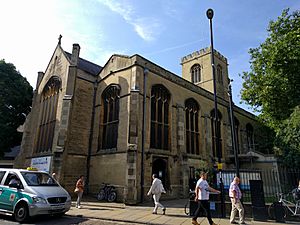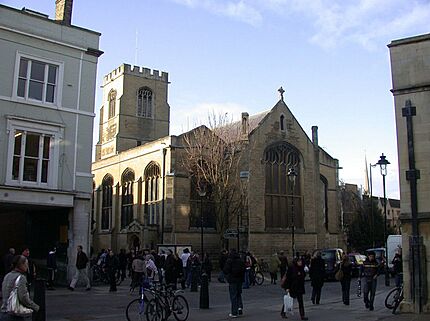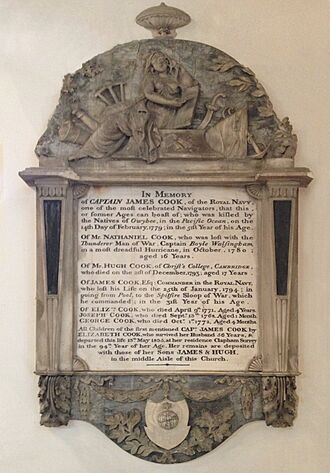St Andrew the Great facts for kids
Quick facts for kids St Andrew the Great |
|
|---|---|
 |
|
| Country | England |
| Denomination | Church of England |
| Churchmanship | Low Church / Conservative Evangelical |
| Website | stag.org |
| Specifications | |
| Bells | 8 |
| Tenor bell weight | 10-3-1 in G (547kg) |
| Administration | |
| Diocese | Diocese of Ely |
St Andrew the Great is a historic Church of England church located in the center of Cambridge. The building you see today was built in 1843 in a classic Gothic style and is officially recognized as a special historic building.
The church is known for its traditional, Bible-focused teachings. Its community is a mix of local Cambridge residents, students from the university, and visitors from all over the world.
Contents
The Story of St Andrew's
A church has stood on this spot for a very long time. It was first mentioned by name in the year 1200 and might even be listed in the famous Domesday Book from 1086. The very first church was likely a simple wooden building.
In the 1200s, a stronger stone church was built to replace the wooden one. A few centuries later, during the Reformation—a time of major change in the Christian church—St Andrew's became an important center for new ideas. A famous preacher named William Perkins taught here from 1585 to 1602.
By the 1600s, the church building was old and needed repairs. It was rebuilt thanks to the generosity of Christopher Rose, who was the Mayor of Cambridge twice. Around this time, a man named Thomas Tenison was a minister at the church. He became famous for his bravery in caring for people who were sick during the Great Plague. He later became the Archbishop of Canterbury, the most senior bishop in the Church of England.
A New Building for a Growing Church
The church became so popular that it needed more space. So, in 1842, it was completely rebuilt in the style of a 15th-century church. It was designed by the architect Ambrose Poynter.
The new building had a tall west tower and a large main hall, called a nave, with aisles on each side. Even though it was a new building, it kept some parts of the older church. These include some beautifully carved stone from the 1100s and several wall memorials.
The Captain Cook Memorial
One of the most famous features inside the church is a memorial tablet for the great explorer Captain James Cook and his family. The tablet honors Captain Cook, his wife Elizabeth, and their six children.
Sadly, Elizabeth outlived her husband and all of her children. She died in 1835 at the age of 93 and is buried in the church with two of her sons. In her will, she left money to help pay the church's minister, support five poor older women in the area, and take care of the family memorial.
The Church in Modern Times
By the 1980s, very few people lived in the area around the church, and it was almost closed down. But the story has a happy ending. A nearby church, the Holy Sepulchre Church, had a congregation that was growing so fast they were running out of room.
They raised money to repair and update St Andrew's, adding a new gallery and other rooms. In 1994, they moved in, giving the historic church a new life. The Holy Sepulchre Church, also known as the Round Church, is still used for special events and exhibitions.
St Andrew's has also helped new churches get started. It has sent some of its ministers and members to help grow church communities in other places, including Little Shelford (1997), Christ Church Cambridge (2004), St Matthew's in Cambridge (2008), and Huntingdon (2018).
St Andrew's Today
The church holds public services every Sunday. The services focus on teaching from the Bible and last about an hour. There are also groups for children, teenagers, university students, and international visitors that meet during the week.
The church follows the conservative evangelical tradition of the Church of England. This means it holds traditional views on the Bible's teachings. The parish has chosen to have a visiting bishop, currently Rob Munro, for leadership.
Church Leaders
The main minister of a church like this is called a vicar. These men have been the vicar of St Andrew the Great (or Holy Sepulchre before the move) since 1955:
- 1955–1987: Mark Ruston
- 1987–2010: Mark Ashton
- 2011–present: Alasdair Paine
Other Important People
Over the centuries, many well-known people have been connected to the church:
- William Perkins: A famous theologian who taught at the church from 1585 to 1602.
- Thomas Tenison: A minister here in the 1660s who later became Archbishop of Canterbury.
- Temple Chevallier: A minister and astronomer in the 1820s who later became a Professor of Astronomy.
- David Watson: A minister here in the early 1960s who became a well-known Christian author.



